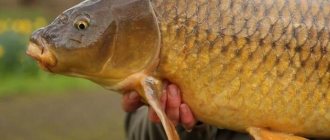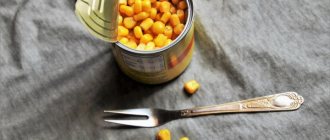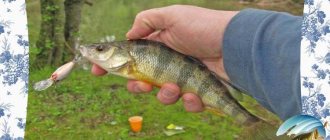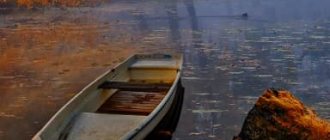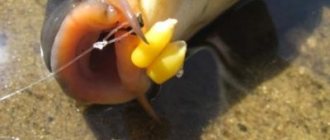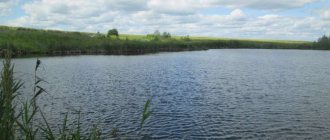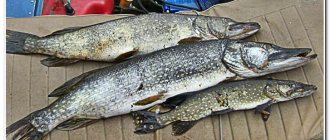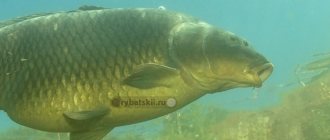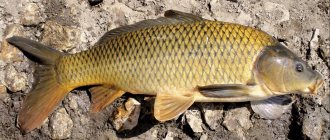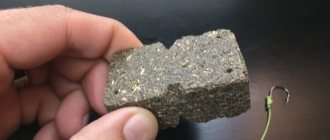Carp is a cautious fish, and the fishing techniques used for other fish may not be suitable for it. For such fishing for big fish, you need to take into account the rules for using gear, and also be able to prepare your own bait and choose the place where this fish is found.
Unlike other fish, carp has quick reactions and a restless character. It is best caught with a regular donkey. True, you will have to take into account the factor with the flow.
If you catch a large carp, you will have to take into account the requirements for a load of up to 50 kilograms (due to possible jerks of the fish). Pay special attention to the fishing line, preferably with a smaller diameter than monofilament.
For a beginner, it is best to choose calm waters to get acquainted with fishing.
Donka fishing involves encountering obstacles in the form of:
- bushes;
- driftwood;
- algae;
- fallen trees, etc.
In a quiet body of water or with a fast current, the fish still chooses the above areas for its life activities.
It is equally important when catching carp from the shore to take into account the choice of bait and feeders, which will depend on fluctuations in the flow of the reservoir. The feeder must have an inertia-free mechanism with a friction brake.
Equipment
Equipment such as the “pacifier”, which is used by amateurs, has proven itself no less. To assemble it you will need:
- feeder (spring base);
- hooks (up to 4 pieces);
- fishing line for leashes.
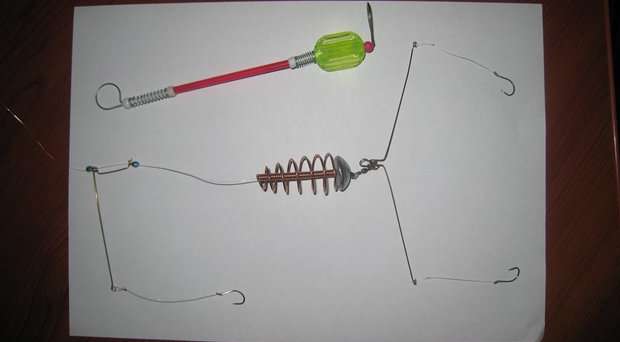
To assemble the tackle you will need to do the following:
- A feeder, which is a spring, is fixed to the fishing line;
- A bead stopper is attached to it;
- Leashes are made from braided wire;
- The bait is placed on hooks.
You can increase your fishing efficiency in the following ways:
- Use a pheromone additive that is suitable for warm and cold water.
- Use several hooks.
- Choose several places for fishing.
From the point of view of line breaks, a monofilament line with a diameter of 0.3 mm is quite suitable for catching carp.
You can use thicker fishing line, which serves as a safety net. However, the disadvantage of such equipment is that underwater it creates a sailing effect, and this adversely affects the casting distance.
It should be noted that the feeder rod is a little more than 3 meters long and provides a good casting range. With its help, it is easier to catch fish from the bottom of the reservoir.
Since the feeder additionally serves as a sinker, choose one that weighs no more than 150 grams. It does not interfere with fishing for carp at depth and with the current.
Short shank hooks
When choosing hooks, give preference to a short shank and a serrated tip. They should have a springy hook. You also need to take into account that the size of the hooks will depend on the weight of the fish you plan to catch. For large fish, you will need a size of at least 5, and if a medium-sized fish was spotted, then hook size number 2 is quite suitable.
A feeder is needed to feed fish. You can buy it in a specialized store or make it yourself. If you prepare a feeder with your own hands, you will have to take into account the type of reservoir. They are usually made of round plastic. If the current is fast, the feeder should be triangular in shape and heavy.
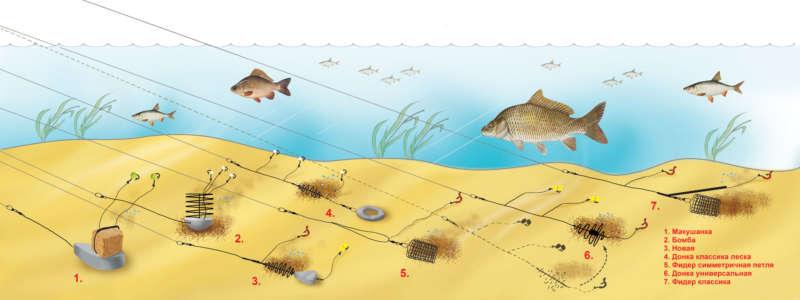
Schemes for constructing donks of different types
Fishing technique and tactics
Setting up the zakidushka is carried out in several stages
Equipment of the fishing site and casting of gear
To cast the gear, we will need to free up space on the shore. If you have to fish at a point with overgrown tree branches, we’ll simply secure them with guy wires to free up the sector for working with the rod and unwinding the line when casting by hand.
We put tripods for fishing rods. They can be prepared on shore or steel stands can be used. They must be installed securely. When using a classic donkey, we make grooves for each of them for fixation in the ground. Near each tackle we stick a peg for a bite alarm.
If the shore is heavily overgrown with reeds, we make a small passage for fishing out carp and throwing gear. When going on a night fishing trip, we will prepare a supply of firewood and a camp grill before dark in order to combine business with pleasure.
Bite alarm
Catching carp on a donk will require the installation of a mechanical or electronic guard. For night fishing, it is better to use a backlit alarm so as not to run along the shore in search of ringing gear. There is no need to constantly stay and monitor bites directly near the gear. The electronic device will give a sound and light signal about the bite.
Depending on the price, they can be equipped with additional functions, but, in essence, this is a waste of money for unnecessary options. For fishing in daylight, it is enough to install simple systems from lumps of earth, split twigs, or use familiar bells. The choice is individual, but installing a guard on the donkey is mandatory.
Carp bite
Bottom tackle is made on the principle of gradually swallowing hooks and releasing them into the gill slits. Therefore, we do not recommend rushing and pulling the tackle when the alarm goes off for the first time. And when a carp that has been caught and pricked pulls hard on the tackle, trying to get rid of the pain, there is no point in yawning. Smoothly pull the line and, making sure that the prey is on the hook, begin an exciting fight with a strong opponent.
Fishing
After the first carp you catch on your own, you will be convinced of the veracity of the words about its great reserve of strength. Having caught a trophy specimen, it will take you seven sweats until the prey ends up on the shore. You should not try to pull the fish by force, as you risk losing not only the trophy, but also the donk.
At first, the carp actively resists, as a result, it is important to exhaust it so that it gets tired and takes a breath of air. But before that, be sure to unwind the line a little from the reel when the fish jerks, trying to soften their destructive ability. Only after moving the trophy and exhausting it with struggle can you begin to pull it by force to the shore. But we remain careful; the carp can throw out several knees right near the shore. Here we can only hope for the help of friends and a landing net.
Donka is a passive type of fishing, but whoever claims so has probably never caught this golden beauty and taken a selfie with the catch when the fisherman looks more tired than his trophy. There are many methods of fishing, choose the one you like and go off to meet the sun and enjoy unique minutes of exciting competition with a strong opponent.
Lures
A few grains of corn have always been considered an excellent bait for carp and carp.
Plant and animal bait is the basis for catching carp. There is a wide variety of lures, and here are the most popular ones.
- We take potatoes , preferably ones that do not fall apart after cooking. Throw it, unpeeled, into boiling salted water for about 20 minutes. Then peel the potatoes and cut them into cubes. This will be an excellent bait for carp.
- Millet porridge is good for carp. To prepare the bait, you need to take a bag of porridge and put it in the oven so that it evaporates. Then cool the porridge and cut it into squares so that they fit the hooks.
- Ripe corn kernels can be boiled in salted water and then dried. Fish like them.
- peas , especially if they are soaked for 24 hours in a soda solution and then boiled in a gauze bag for about one hour.
- Dough in the form of balls is excellent as bait for carp. For cooking you will need flour and vegetable oil. You can also add berries, vanillin or anise - their aroma has a specific effect on fish.
- various berries as bait :
- grape;
- Rowan;
- cherry;
- raspberries, etc.
They are placed on the hook so that it goes around the bone.
Store all baits in wooden boxes with holes in a cool place.

If you buy bait, then stop at boilies. There are a lot of tastes and in all bodies of water the preferences of carp are different. Start with diametrically opposed tastes - fishy and sweet. Test it.
Fishing with a glass.
Hello everyone. I decided to share a method for catching carp using the so-called glass. We have been using this method for a long time with success. To begin with, take regular feed corn and cook until softened. Put 2-3 grains of corn on a thread leash about 30-40 cm long. .A swivel is tied to the other end. The leash with the hook is lowered into an ordinary plastic cup and filled with corn so that the swivel with a small piece of the leash remains on the outside. After this, the glass is filled with water and placed in the freezer. A sliding weight is put on the main fishing line of the tackle, the weight of which depends on the current, and the fishing line is attached to the socket. Before casting, the cup is lowered into the water for a few seconds, after which the plastic is easily removed. All this stuff is thrown into the water where the ice melts, leaving the equipment in a pile of bait. Packing simple tackle allows you to increase the chances of a bite. at 40-50. In the summer I store the glasses in a Thermal Bag, in the winter there are of course no problems with storage. In the program fishing with Razdishevsky there was a story showing this equipment. If anyone is interested, I will post photos of the preparation process later.
The cup looks like this. A good alternative to PVA mesh. AUTHOR: Alexander2, https://www.rusfishing.ru/forum/showthread.php?t=28448 fishinform.blogspot.ru
Lure
We do not recommend catching carp using bait containing animal origin. Insects or worms will scare the carp away from the feeding area, but will attract a predator.
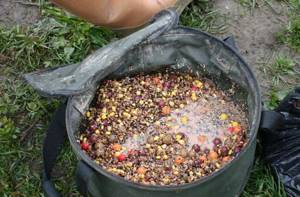
Groundbait at home is made from the following ingredients:
Recipe No. 1. Add corn and peas to boiling water and cook them for 10 minutes. Then remove the pan from the heat and let them brew in their own juice. Then drain the water and place the bait in an airtight container. Already while fishing, mix this bait with soil from the pond and throw it into the water. Carp like this bait and will help catch a large specimen.
Recipe No. 2. You can make dough balls with the addition of flaxseed oil and various worms.
Recipe No. 3. Using pearl barley porridge with the addition of shellfish, which can be found in fresh water.
Recipe No. 4. Mamalyga or corn porridge, to which various flavors are added:
- mint;
- strawberries;
- chocolate;
- lemon balm;
- anise and so on.
This bait is better suited for summer fishing.
We use boilies
Today this is the most effective way of fishing. The likelihood of meeting our ward is high. You need to use boilies with a diameter of up to 2.5 cm. It is not recommended to use balls with strong odors (garlic, vanilla, anise). You can buy the finished product at any specialized fish store, where you are provided with a wide selection. In addition, there is the opportunity to consult with the seller, who, most likely, is an avid fisherman himself.
Catching carp page
will reveal to you all the details of such fishing.
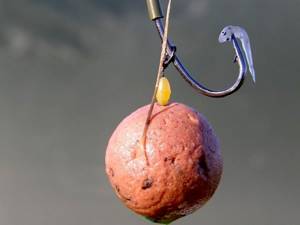
Fishing technique
After choosing a place, feed it so that the fish gets used to the food and the place where there is more food. It is best to fertilize a week before fishing and preferably at several points in the reservoir at once. Those who are not satisfied with this choice can always stop at one place.
It is advisable not to make unnecessary sounds that will scare him away while fishing. When feeding, you should not create extraneous noise around you.
When fishing techniques, follow the following rules:
- Keep an eye on the rod and the bite.
- If large fish do not appear, and young fish are swimming around, you can add food.
- You can’t move too far from the fishing rod so as not to miss the hook.
Follow these tips:
- you need to fish with one rod;
- if there is no bite, re-cast the rig;
- If you lose your bait, you can add new bait.
- The fishing spot must be baited in advance.
Carp nutrition
In the spring after hibernation and at the beginning of summer, the carp feeds mainly on young shoots of sedge, water lilies, reeds, pondweed and other vegetation. It actively eats the eggs of spawned fish and frogs. The summer diet of carp shifts towards such animal inhabitants as insects, snails, worms, molting crayfish, leeches, pearl barley. Leaves of aquatic plants also remain on the summer fish menu. But in the fall, the carp completely switches to animal food, eating invertebrates and aquatic insects.
How to choose the best place
Carp chooses warm water with a slight current for its habitat, where the river depth reaches more than 3 meters. He is used to feeding from the bottom with larvae and crustaceans, as well as insects that live in the mud.
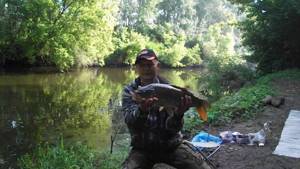
Near steep banks, where the depth is about two meters, carp prefers to feed on dragonfly larvae.
The best places where you can find carp (even visually by splashes):
- river mouth;
- areas with reeds and water lilies;
- places where there are old sunken trees.
If a fisherman wants his fishing to be exciting and a good catch, he will have to take care of the fishing spot in advance. Therefore, you need to feed the fish in advance.
To decide on a location you can:
- use an echo sounder;
- ask knowledgeable fishermen;
- observe the fish and its camp in advance at dawn - he likes to splash on the surface of the reservoir at this time.
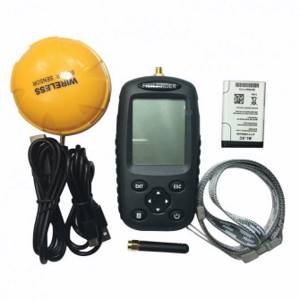
Depending on the seasons, carp behave differently:
- Fishing for carp begins in May. The fish begins to actively bite on any bait. After spawning, it loses activity;
- at the end of June in the morning and evening hours the bite is successful;
- until the end of September the fish bite is excellent, and with the onset of October it begins to prepare for the winter;
- We must not forget about weather conditions, because in bad weather the bite level decreases. Low blood pressure has a depressing effect on the life activity of carp;
- in rainy weather, rarely anyone will be able to catch fish, since usually there is no bite.
Using a boat
Having anchored the boat, the feeder is lowered into the water. The food is placed in a net or gauze so that the current gradually washes it out. The fish is given a signal about the location of the next portion of food.
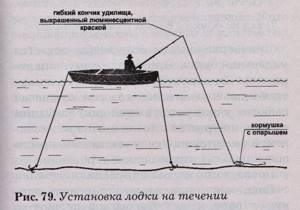
Method of capture, donk. The simpler the installation, the better. The weight of the stick with dough is 200 grams. The reel can be taken of the “Nevskaya” type, provided that it slows down and will not be pulled downstream.
Although this happens rarely, and only with inexperienced fishermen. Perhaps the tackle rises in the water due to the wrong choice of sinker weight. Fishing line with a diameter of up to 1 mm will be enough “with your head”. This is for those who are afraid of large specimens coming off. Most fishermen use fishing line up to 0.6 mm. When “silent hunting”, a sinker weighing 180-200 grams is taken from a boat in the current. You must use a leash. Recommended length: up to 50 mm. No more.
It is not recommended to use a braided leash on rapids. The bait will constantly twist the leader, working like a propeller. It’s better to do the opposite: use braided line as the main line.
It is less blown away by the current. The diameter of the gear can be 0.15-0.18 millimeters. This is an ideal solution for bottom tackle. When fishing with the bottom method, carp hooks Nos. 1,2,3 are recommended. It will be better if you have leashes of different lengths with hooks in your arsenal. Then you can quickly change them if necessary.
Read more about fishing for carp from a boat here
.
Features of catching carp on a donk
Since carp is recognized by fishermen as a cautious fish with a changeable character, some points need to be taken into account, especially when caught from the shore. So do the following:
- Know how to camouflage yourself in the reeds.
- Learn to attach him at the same time. This can be achieved through timely feeding, which is carried out before fishing.
- Feed with food of plant origin.
It should be noted that in a strong current, the load should be heavy, and using a donkey with such a load is just right in such a situation.
On a float rod from the shore
Oddly enough, but using a fishing rod to catch carp is a rare phenomenon in comparison with bottom gear. But the fishing process is more exciting. If there are deep places near the shore, more than 4 meters, experts advise fishing them.
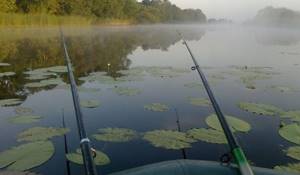
The sinker and float are installed on a sliding shooting range in the form of an olive. You need to adjust the float to the depth at the fishing spot and secure it with a locking knot. This is done so that it does not move towards the rod. The sinker is held in place by a bead. You can use a rubber stopper.
When caught on a fishing rod 4.5 meters long, a leash 10-15 cm long is placed. You can use a fishing line or 0.3 mm cord. The casting range will be 50-80 meters. An inertial reel with a line on a spool of at least 100 meters is recommended. Special hooks for carp No. 8 with a sting and a shortened shank.
If you need to cast a short distance from the shore edge, you can use a 2.5 meter stick. Recommended test up to 200 grams.
When catching from the shore, it is better to install several donks at once, with a spring and a feeder and different attachments.
WE RECOMMEND!
If the feeders are heavy, the gear can be delivered to the selected location by boat. The feeder must contain at least 200 grams of food!
One person on the shore controls the gear. The second one on a spoon delivers the feeders to the fishing point.
In places with strong currents, it is not recommended to use feeders with holes on the sides (container type). If maggot is chosen as bait, it will spread in a short period of time, the current will speed up this process.
In weak currents, it is recommended to use container-type feeders. And further. The cargo is selected based on:
- he must deliver the feeder to the bottom and hold it in the current;
- the load should allow you to cast with the chosen stick with the specified test.
Important Tips
- The use of high-quality tackle will help withstand the load of strong fish at the time of fishing.
- Weather conditions play an important role in fishing. In dry sunny weather, carp will bite reluctantly, just as during a storm. Therefore, you will have to choose more optimal weather.
- The fishing spot must be chosen in advance and baited at a certain time.
- Since carp has a well-developed sense of smell. He is attracted to bait that contains odorous aromas.
- The most favorite bait for this fish is a “sandwich” made from dough, maggots and corn. Such food will whet his appetite, and perhaps. It will be possible to catch a large specimen.
Who's on the hook?
According to the owner of a Rostov fishing store, a fisherman with 20 years of experience, Alexander Shatalov, such restrictions will primarily hit the pockets of ordinary amateurs who occasionally go out into the countryside to fish.
“I do not share the opinion that ordinary amateur fishermen cause damage to aquatic biological resources. The same cannot be said about poachers.
I doubt that the new rules on the Don will result in fewer illegal fish being sold under the counter. They have been making a living and will continue to do so.
But all the introduced fines will fall on the shoulders of ordinary fishermen, who often cannot even distinguish one fish from another,” says Alexander Shatalov.
And here's what you need to know: How to cut off small crucian carp to catch large ones
